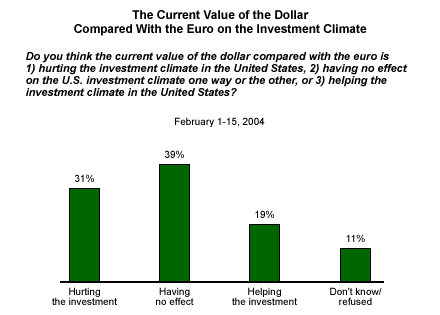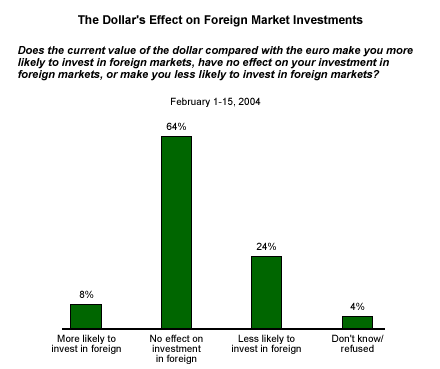Given the combination of ever-increasing deficits and low interest rates, the decline of the dollar against other benchmark currencies is not difficult to explain. The appreciation of the euro relative to the dollar has been remarkable, even as the Japanese central bank intervenes actively to keep the yen in check and China maintains its currency peg.
The continuing decline of the world's reserve currency makes for interesting times in the currency markets, and corporations have largely hedged their currency risks. The extent to which investors might have hedged their currency risks was not addressed in the latest UBS/Gallup Index of Investor Optimism survey*, but it did examine investor perceptions of the relative strength of different currencies, the macroeconomic impact of the declining dollar, as well as how investors plan to reposition their portfolio investments.
Investors Less Confident in Greenback
In a question probing opinions about the most attractive currency, Gallup asked investors to rank the relative attractiveness of the U.S. dollar, the Japanese yen, the euro, and the British pound. Investors have been asked this question periodically since April 2002, and every time, a majority of U.S. investors have ranked the dollar as the most attractive currency. But as of February 2004, the percentage rating the dollar as most attractive (57%) is lower than it has been at any time since Gallup first asked the question.
The euro places at a distant second on the attractiveness scale. At 24%, nearly one in every four investors ranks the euro as the most attractive currency. Investors express the least conviction in the attractiveness of the Japanese yen and the British pound, with only 7% of investors rating the yen as most attractive, followed by 5% choosing the pound.

Impact on Investment Climate
The data show that investor confidence in the greenback has declined since April 2003. But a plurality of investors (39%) believe that the current value of the U.S. dollar compared with the euro is having no effect on the investment climate. While 31% of investors believe that the value of the U.S. dollar compared with the euro is hurting the investment climate, another 19% express the opposing view, saying that the value of the dollar compared with the euro is in fact helping the investment climate.

The split camps evident in these responses surely speak to the diverse impact of a weakening dollar on different interest groups. While American manufacturing has suffered in the face of cheaper imports, the weak dollar has made American exports more competitive and been credited with helping the economic recovery.
A large percentage of Americans believe the value of the dollar compared with the euro is having no effect on the investment climate. But an even larger percentage of investors (64%) say that the current value of the dollar compared with the euro will not affect their investments in foreign markets. And while 8% of investors say the current value of the dollar compared with the euro makes them more likely to invest in foreign markets, three times that number of investors (24%) are actually less inclined to make foreign investments.

Bottom Line
Inflation seems to be rearing its head again in the United States, with import and commodity prices as well as core inflation all showing signs of rising. In fact, core inflation rose in January after posting declines for the last 16 months. And given where these economic indicators are pointing, the possibility of an interest rate hike by the Fed is becoming more real. On the other hand, with inflation in the Eurozone falling to 1.6% in February, along with the increasing political pressure on the European Central Bank to cut rates as the appreciating euro makes exports less competitive -- it might well be that the European Central Bank will cut its key rate when it meets on Thursday.
As a result, it looks as though the long slide in the dollar is bottoming out. Regardless, given the investor responses to Gallup's attractiveness question, and the relative confidence that investors express in the benchmark currencies, it is apparent that the dollar is very much still the reserve currency of the world, as far as most American investors are concerned.
*Results for the total dataset are based on telephone interviews with 863 investors, aged 18 and older, conducted Feb. 1-15, 2004. For results based on the total sample of investors, one can say with 95% confidence that the margin of sampling error is ±4 percentage points.

